Knitting, crochet, sewing. All crafts which have long been viewed as frumpy, dull hobbies for the older woman. However, a new, younger generation of crafters has emerged from the pandemic- determined to challenge these stereotypes. But is fast fashion, the economic crisis, or Harry Styles’ cardigan responsible for this woolly revival? Madison Bown finds out.
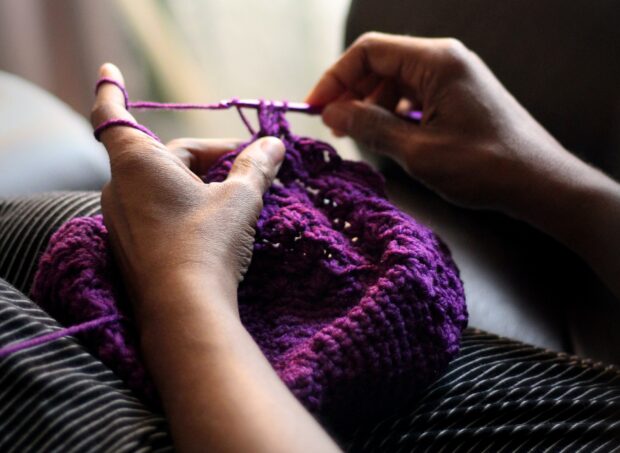
If I say knitting, what immediately springs to mind? An old woman, sat in front of Coronation Street? Rollers in her hair and fluffy slippers on her feet? Perhaps she’s surrounded by a group of other old women, all with their needles clicking and voices chattering.
Now imagine a cosy pub, with pillar box red walls plastered with sheet music. The Arsenal v Oxford match is on the TV and if you strain your ears hard enough you can hear Billy Ocean’s Love Really Hurts Without You playing under lively chatter. The lighting is dim and ambient but not so dim that people can’t see what they’re doing.
Tonight’s pubgoers are knitting.
Sticky tables usually populated by people knocking back pints are instead littered with mountains of wool and needles and scissors and yarn.
This is the Birdcage pub in Lincoln’s newest venture: ‘Yarned and Dangerous’, a knitting group that runs every Monday.
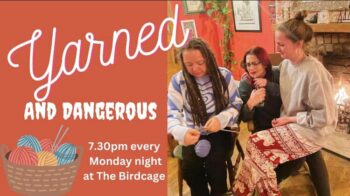
It’s the brainchild of staff members Laura Louise Kelly Buttle and Gemma Baker. When Laura and Gemma set up the group- Laura wanted to learn how to knit and Gemma wanted to rekindle an old hobby- they had no idea how popular it was going to be.
‘’That’s how all the clubs start here. As a bit of a joke but this has really grown over the weeks,’’ Gemma tells me.
And looking around, there is no clear demographic. Young, old, black, white. I’m even told the male regulars have been known to swap the pints for purling.
This group is one of many across the world that are changing the stereotype of domestic crafts as frumpy, old-fashioned activities.
During the pandemic, more and more young people found themselves picking up knitting needles.
As with most things nowadays, TikTok seems to be a driving force in this trend.

In February 2020, Harry Styles wore a patchwork, crochet cardigan by designer JW Anderson, which kicked off a trend of young crafters trying to replicate it.
A quick TikTok search shows the hashtag #harrystylessweater has 4.6 million views.
Meanwhile, the hashtag #crochet has 13.9 billion views.
All out of crochet projects, 20-year-old student Rose Read tells me why so many young people are getting into craft while she darns a pair of fluffy socks:
‘’I think a lot of young people have this constant sense that the world is falling apart at the moment, and it just feels comforting to have some kind of skill under your belt. Mending or making stuff feels like a moment of calm in a time of unrest’’
Like many university students who enrolled in 2020, most of her time was spent in student accommodation. Lectures were online, clubs were closed and although her 20 other flatmates were lovely to be around, she needed some time to herself.
After her mum tried to teach her how to knit as a child (‘’it was disastrous’’ she chuckles as she sips an Irn Bru) being cooped up during the first lockdown convinced Rose to give crochet a go and she has ‘’not been able to stop since’’.
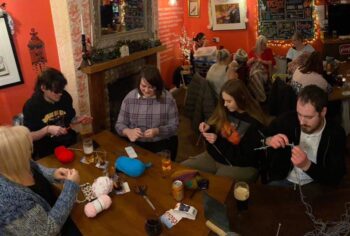
Despite being the youngest at her table, Rose isn’t put off. ‘’It’s been really nice for me to have a social space separate to my usual friendship groups. A lot of the people I usually spend time with are at uni and stressed about uni so it feels good to have other kinds of interactions as well, regardless of age.’’
Besides lockdown boredom and anxiety, there are many other factors that could be pointing to a resurgence in craft and repairs.
As the world becomes more aware of the consequences of fast fashion, and more conscious of making sustainable, ethical choices, it seems DIY fashion is on trend.
Research conducted by Samsung for Graduate Fashion Week finds that over 60% of young people are ready to ‘ditch fast fashion.’
Meanwhile, data from market research company Mintel shows Gen Z consumers are driving the Arts and Crafts market.
But the pressures of fast fashion and the towering cost-of-living crisis are pushing people of all ages and backgrounds to try their hand at a new craft.
John Lewis revealed sales of safety pins were up 21% going into the new year, with sales of knitting needles also seeing a boom of 6%. Other dressmaking accessories, such as tape measures and thimbles have seen a year-on-year increase of 15%.

Susan Kennedy, haberdashery lead for John Lewis, said: “We’re certainly becoming a nation of craft lovers. Whether they’re looking to rejuvenate their clothes, or have been inspired by the likes of Tom Daley’s knitting efforts last year, we’re seeing more and more customers turn to sewing, stitching and knitting.’’
This is something Prikli Pear Founder and Creative Director, Jessica Purdie, feels passionately about.
Besides her weekend gig as an ABBA tribute act, Jess runs the fashion brand/alterations service, alongside craft workshops across Lincolnshire.
After starting a job in a PR firm in London in September 2020, Jess soon realised she had joined a rat race of people who put on a professional persona that left them unhappy with their lives.
For Jess- who grew up on a small farm in Highland Perthshire- she realised the same lack of transparency lay in fashion and decided to leave the Big Smoke and fully launch Prikli Pear in Lincolnshire.
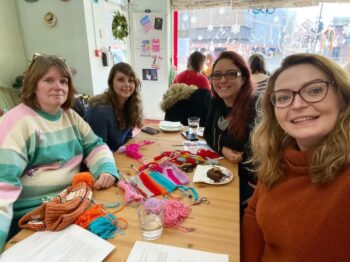
Chatting to her about how hectic her schedule is, she just laughs it off and says ‘’I am chaos.’’
But her bubbly, honest, and driven character has helped Prikli Pear take off since its foundation in September 2021, and she is now hoping to take her Stitch and Bitch ‘’female creative’’ sessions nationwide.
‘’I think it’s about using your time really wisely and if you’re creating something or working towards an end project it releases more endorphins than mindlessly scrolling on your phone.
‘’When you can see a project coming together, you get these endorphins and this excitement and I don’t think we get that from our phones.’’
Although her workshops are filled with a range of women, she has noticed more and more young people getting involved in domestic crafts:
‘’I think we’ve got some real pioneers like Tom Daley, Hope Macaulay, amongst other small businesses, who are challenging the stereotypes surrounding knitting.
‘’A whole community of crafty people has emerged from the lockdowns, and we’ve got this new scene of young people who are making knitting and crocheting trendy again.’’
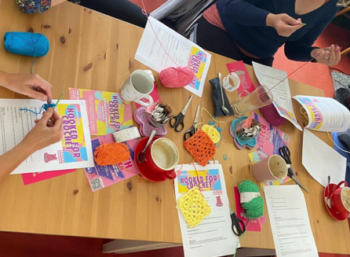
Much like Yarned and Dangerous at the Birdcage, her workshops are a small but welcoming community, and a chance for people across generations to open up to each other and share their love for crafts.
Mandi Hill has been crocheting for over 50 years, and as I lament my inability to do anything creative, she shows me how to form a chain.
She switches off the reader light dangling around her neck- think E.T’s fingers- and sets down her blue and green granny square.
It’s a full circle moment for Mandi, whose love of crochet kicked off when her aunt taught her how to chain stitch when she was young.
‘’As I got older, I picked a few things up from friends, older friends because it was an old-fashioned thing to do in those days, and when I left school at 16 I started going to a local knit and natter in our village.’’
Despite the resurgence of crochet on social media and major fashion brands, Mandi says stigma still prevails:
‘’Some people tell me ‘you’re not ready for your slippers yet!’ and it does get my goat up a little, but crochet is coming back, and I’ve seen people of all ages sat in cafes having a knit and natter.’’
But knitting hasn’t always been associated with older women.
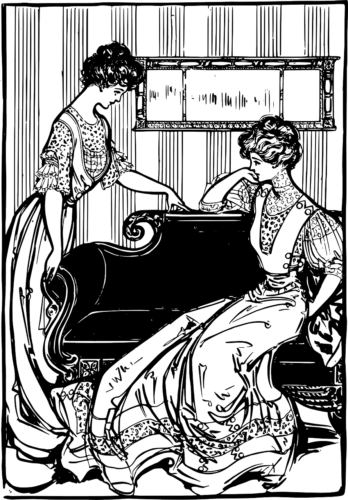
According to historian and author Penelope Hemingway, knitting used to be a highly valued skill, with some men even aiming for the prestigious title of knitting ‘master.’
However, by the mid-19th century it became associated with domesticity, and hence femininity, relegated to rich, white women with nothing else to fill their days with.
Penelope tells the BBC: “For the middle classes, it became a parlour hobby, consigned to the part of women’s lives lived in the spaces between men’s more public-facing lives. This ‘feminising’ led to knitting being perceived as an ‘idle’ waste of time; a feminine pursuit to be followed safely from within the cage of domesticity.”
Thankfully, times are changing.
Whether it’s due to TikTok, ‘pioneers’ like Tom Daley, economic pressures, or groups such as Yarned and Dangerous, it’s clear there is a revival of a dying art. And from the looks of it, Generation Z are leading the way.
Much like Mandi’s aunt, Rose’s mum, and Jess’s granny taught them, hopefully this new generation of wool-lovers can pass down this intricate art-form and unravel the stigma, one stitch at a time.

